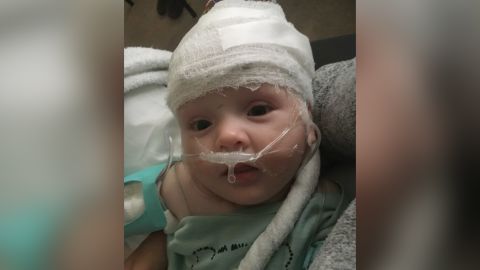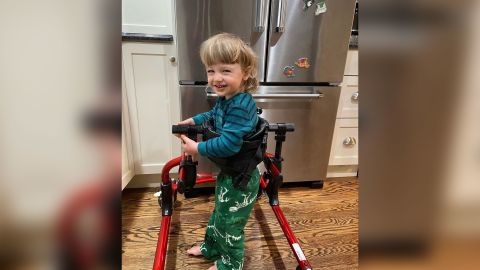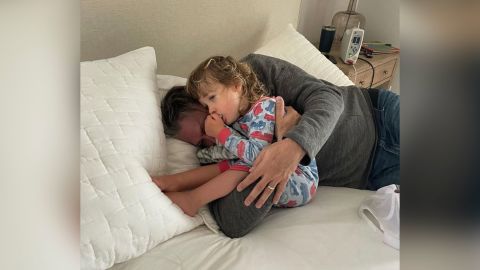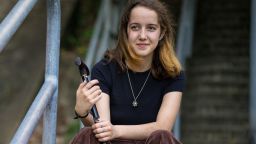Editor’s Note: This article contains an image of someone having a seizure.
Mary Saladino spends most of her days holding her son in her arms while he violently seizes, whispering to him as she frantically tries to save his life. Nearly every day she witnesses her baby waver on the brink of death, not breathing and often paralyzed.
Her 3-year-old son, Henry, suffers from alternating hemiplegia of childhood, or AHC, a rare neurological disorder whose patients are referred to as “human time bombs.” At any moment, Henry can stop breathing, have a life-threatening seizure or become paralyzed – and there’s no way to know when it will happen or if he will survive.
No treatment or cure exists for AHC, which affects one in a million people globally, according to AHC expert and neurologist Dr. Kathryn Swoboda, and families of patients with this unpredictable disease never stop watching for signs of an oncoming episode. As soon as it strikes, they must act quickly to administer lifesaving measures.
“When you’re feeling that fear you’re going to lose your child, you have to be thinking what would I want to give him as his mom if this is it? I want him to hear how much we love him, but also oh my God, I have to save him, what’s his oxygen level? Do I need to resuscitate him? Did I give the first dose of rescue medication?” Saladino told CNN. “It’s an unbelievable amount of trauma and it’s going to happen over and over again, no matter what we do, until we develop this treatment.”

Despite its name, AHC does not affect people only during childhood. It only worsens with age, according to Swoboda, with patients often losing most of what they learned as children, such as walking, talking and eating independently.
In 2022, Mary and her husband Anthony launched the nonprofit foundation For Henry to raise $3 million for a genetic treatment that, if successful, could be the first to treat AHC and pave the path for others living with the disorder to receive treatment.
Through their foundation and GoFundMe fundraiser, the Saladinos are raising the remaining $2.5 million needed to design from scratch an antisense oligonucleotide, or ASO treatment, which would knock down the toxic impact of a genetic mutation that is causing the dysfunction in Henry’s brain.
The family is racing to develop and administer the treatment before Henry’s brain is irreversibly damaged during one of his spells. This risk increases every time Henry survives another seizure in which he stops breathing on his own – sometimes for up to 15 minutes – or experiences paralysis that can last for days at a time, his neurologists say.
“We have reached a point where, as a clinician, I am unable to provide Henry with a better option to try and prevent him from having more seizures or episodes,” Dr. Christelle Achkar, Henry’s neurologist, told CNN. “Henry is one of those children who are at higher risk of premature death due to their condition, and if they survive, there is always a concern of potential for severe regression. This is his only chance.”
If it works, according to Swoboda, this would also establish proof of concept that this type of therapy might be developed to treat several other neurological syndromes caused by mutations in the same gene – including a rare type of Parkinson’s disease.
“While this is about Henry, it is also about many other patients whose lives can be impacted by this therapy,” Achkar said.
What AHC does and how an ASO treatment can help
In one instant, Henry is dancing and singing as his parents dress him in pajamas. Suddenly, he goes limp, half of his body paralyzed and the other half violently convulsing as his parents rush to administer drugs and oxygen.
Many things can trigger the episodes, such as a bath or sunlight, but especially moments of stress or excitement. Holidays, birthdays and even play dates can be too overwhelming, Henry’s parents say, and they have to watch him transition from delight to suffering at their happiest moments.
“AHC is the worst disease I have ever worked with in terms of the level of stress, for both parents and physicians. Episodes can strike at any time, and it is not readily clear when an episode is going to be catastrophic and require a hospital visit or urgent intervention,” Swoboda, Henry’s former neurologist, told CNN.
“They have to reconsider everything,” she added. “You can’t take them to a mall with bright lights and excitement. If you take them to a swimming pool and it has cold water, they might go down. If they get too excited before their therapist is going to come over, they get paralyzed and can’t do their therapy.”

AHC can be caused by 163 different mutations in the ATP1A3 gene, but three mutations, including the one that Henry has, account for 75% of cases, according to Swoboda. The ATP1A3 gene encodes a sodium potassium pump critical for maintaining a normal electrical gradient in all neurons in the brain. It is vitally important.
“It’s like your power goes off in your house and you have a backup generator, but your backup generator isn’t working so well,” Saladino said. “We see the disease manifest at moments when Henry’s tank is running low. It could be when he’s too hot, tired from climbing upstairs, or he’s hungry or his brain was working too hard during therapy.”
Because of the faulty pump, Swoboda says, having AHC is like having seven neurological conditions at once: paralysis similar to a stroke, seizures like epilepsy, low muscle tone like cerebral palsy, movement problems like Parkinson’s, neurodegeneration like Alzheimer’s, behavioral issues similar to attention-deficit/hyperactivity disorder and behavioral challenges like autism.
Henry, who suffers from the most severe mutation, has a significant speech delay. He is able to understand everything being said to him but struggles to produce words. He also has significant gross motor and fine motor delays, meaning he can’t walk on his own and struggles to perform tasks like using utensils.
While AHC foundations are currently pursuing other strategies including gene therapy and gene editing, nothing has been developed yet and an ASO treatment is still Henry’s quickest and best chance to slow the inexorable progression of this disease, his neurologists say.
ASO’s are short strings of nucleotides that can be imagined as small strings of DNA or RNA letters that can interfere with RNA processing. They work by either helping the body create missing good protein or by knocking down toxic protein, according to the Yu Lab, a research laboratory run by Boston Children Hospital neurologist Tim Yu.
“For his exact mutation, if you think about DNA, you have two copies of everything. He has one good copy and one abnormal copy. Not only is his bad copy improperly functioning, it’s also preventing the healthy copy from functioning properly,” said Achkar, a neurologist at Boston Children’s Hospital and an expert in designing and conducting clinical trials involving ASOs. “A knockdown ASO would target the abnormal copy of the gene, by preventing it from turning into the abnormal protein, without affecting the healthy copy.”
Henry’s current and former neurologists are optimistic that an ASO treatment could be successful in eliminating or dramatically minimizing Henry’s frequent episodes and allow him to resume a healthy and normal developmental trajectory.
A treatment that could make history
Through their foundation For Henry, the Saladinos are operating as a biotech company by pushing research, hiring scientists and working with laboratories to develop the drug from scratch.
Although Henry would be the first with AHC to receive a treatment, parents of children with the rare disease have provided tremendous support in driving research to develop the drug for Henry.
“While Mary is driving the bus, the AHC community is working together to support the effort,” said Nina Frost, whose daughter Annabel has AHC and was the inspiration behind their family’s nonprofit, Hope for Annabel.
“If Mary – and Henry – can prove that an ASO works in an AHC patient, they will be providing a tremendous service to the entire community,” Frost said. “Mary is taking on an incredible burden of risk, and much of the burden of cost, for Henry but also on behalf of the other patients in our community.”
Using the money raised so far, scientists have developed all of the potential candidate ASOs, and a team of researchers led by pharmacologist Dr. Alfred George at Northwestern University is currently testing them in Henry’s neurons to determine the most effective ASO.

Scientists with the Rare Disease Translational Center at The Jackson Laboratory will then test ASOs in a mouse model that has the exact same mutation as Henry and also has similar symptoms. Scientists will inject the ASO into a cohort of these mice to see which symptoms they improve and how well they improve them.
After toxicology and animal testing to discover any safety risks, the chosen ASO will then be injected into Henry’s spinal fluid.
“The biggest risk is unpredictable side effects, but that’s why so much time and money is being spent on pre-clinical drug development to test for all potential toxicities until we can be as sure as possible that it is safe for Henry,” Achkar said.
This process of developing the treatment cannot continue without the remaining $2.5 million, which the family must raise on their own.
“Pharmaceutical companies aren’t as interested in helping if there’s a much fewer number of cases, so when you’re talking about an ultrarare condition like AHC, it’s not going to be profitable for pharma,” Swoboda said.
Once they have raised the money, according to Swoboda, it is expected to take between 12 to 18 months to complete all testing and hopefully treat Henry.
“I think he’s still young enough to benefit, but if he has to wait another five years it might be too late to make a substantial difference,” Swoboda said. “You’re going to completely change his destiny. We have to do something.”
If the ASO treatment works, it could very likely treat others with AHC who share either the same mutation or same variant as Henry, according to Achkar. For anyone with AHC, this could prove an ASO can work to treat the disease.
Because the gene is associated with 10 other severe neurological diseases, this ASO treatment targeting the ATP1A3 gene could prove that an ASO may be able to treat these conditions too.
‘It is killing us all slowly’
When asked what she loves about Henry, Saladino laughs as she describes his giggle and love for dancing and books. He is known for his long locks and giving people kisses the moment he meets them. Every time he wakes up from a seizure, he searches the faces around the room to find his mom’s and immediately gives her a kiss.
“Henry is the love of our life,” Saladino said, her laughter turning to sobs. “He is a beautiful child inside and out. I don’t want to imagine a life without him in it.”
Saladino regularly shares photos and videos on social media showing the heartbreaking nature of Henry’s condition, especially during episodes in which he is seizing or not breathing, to raise awareness on the reality of living with AHC without treatment.

Today, Henry can experience up to 30 seizures a day, most of which cause him to stop breathing. The symptoms can strike at any moment including when he is sleeping.
His family cannot go anywhere without his emergency bag, which contains oxygen, a device for resuscitation and rescue medication for seizures and paralysis, which don’t always work.
For the first time in three years, Saladino now sometimes drives with Henry but only to preschool, her eyes always jumping from the road to her rear view mirror in case he is on the verge of a seizure.
Although she has nurses that help watch Henry, she finds herself unable to rest – her showers last no more than a few minutes, and when he is at preschool, her fingers are glued to her phone in anticipation of the dreaded call that Henry is having an episode.
But somewhere in the middle of incessant seizures and emergencies, the Saladinos have found joy.
“There’s beauty in that, those moments of in between, if we are having a good day or a good hour, and it’s a beautiful sunny day, we’re going to spend it at the beach or lake and be grateful for even one or two hours he doesn’t experience an episode,” Saladino said. “It’s beautiful and brutal at the same time. Every single thing that Henry does or endures, it feels miraculous and terribly tragic at the same time.”

Despite the beautiful memories the Saladinos share together, they are haunted by the unnerving shadow looming over them.
It could happen today, or tomorrow, or in the next minute: the episode that leaves Henry with permanent brain damage that no treatment could fix.
“What we are dealing with is something evil, a terrorizing disease that makes us watch our baby suffer, never being able to do anything to truly save him,” Saladino said. “It is killing us all slowly and it won’t stop killing us until we have a treatment.”
A family is racing to raise $2.5 million to save their toddler, who suffers from an ultrarare neurological disorder that turns babies into 'human time bombs' - CNN
Read More



No comments:
Post a Comment